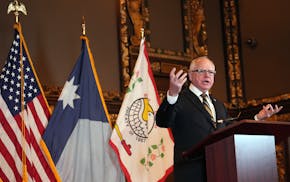DULUTH – A procession of hundreds of Catholics carried a small casket with the remains of the "Patriarch of the Diocese of Duluth" to a new resting place Monday night, as church officials prepare to lobby for his inclusion among the saints.
The short procession to the Cathedral of Our Lady of the Rosary was led by priests, deacons and seminarians dressed in white robes. The remains of the Rev. Joseph Francis Buh, who died in 1922 and was exhumed last summer, were walked through the streets to the recitation of the Litany of Saints.
One by one, the names of saints were recited. Those in the throng chanted "Pray for us."
Buh's casket was placed inside a freestanding dark marble vault, marked with his name and birth and death dates. By design, it is easily accessible to visitors, at the front of the cathedral near a side altar. The process, officially called the Translation of Remains, is rare and usually reserved for people who have already been designated as saints. Buh's is the only interment at the cathedral — and it will remain that way, according to the Rev. Richard Kunst, who is among Buh's primary supporters.
Now the push toward sainthood begins in earnest.
"I'll go to the bishops in the region and look for support in canonization," Duluth Bishop Daniel Felton said Monday night. Then, if supported, he will appeal to bishops across the United States. It would then move on to the governing body of the Roman Catholic Church.
To achieve sainthood, there must be two miracles associated with the candidate.
Nun Jean Castonguay has claimed she was miraculously cured of breast cancer with Buh's intercession. Her story is told in a booklet-sized biography of Buh, which cites "his selfless ministry among the natives and immigrants in north and central Minnesota."
"This is a holy spirited turning point," Felton said. "It's truly going to be not only a moment in history for us, but a divine revelation for generations to come."
Buh — pronounced "boo" — was a missionary who immigrated to Minnesota from Slovenia in the mid-1800s. He was a linguist who came to know several languages, including Ojibwe. By the latter part of the century, he was in charge of nine missions on the Iron Range and beyond.
He created a boarding house for unemployed people and Buh Mission House for priests to find mentorship. He wrote prayer books, started a Catholic union and a newspaper, and incorporated 57 parishes.
He was named vicar general and chancellor of the Duluth Diocese.
When Buh died, he was buried in a metal-lined casket — church officials were already assured that someday he would be exhumed and considered for sainthood.
It's a lengthy process — it could take decades or not happen at all — and most of the people at Monday's Mass won't live long enough to see whether Buh gets the distinction.
Some of those in attendance first visited the Catholic Diocese of Duluth, where the Knights of Columbus gathered in front in full uniform. In a lower level of the building, a display showed artifacts from Buh's life.
Christine Skalko is an archivist who gathered the items in the display. On Monday, she pointed out prayer books, robes and timelines from Buh's life. Her late grandparents were Slovenian and lived in Ely. They knew the priest.
"There is so much I want to ask them," she said.
The diocese building filled with families who were part of a prayer over the casket before the procession began. Then they all filed out and followed the blocklong procession.
Felton's sermon in front of a packed church pulled from Buh's eulogy by Bishop Timothy McNicholas in February 1922, who had referred to Buh as a "saintly priest." The late bishop described Buh's travels to the "wild country" to become a "hunter of souls; fisher of men."
Buh had been dead for more than 100 years, buried in a circle of Catholic priests at Calvary Cemetery in Duluth, when his body was exhumed last summer. The remains were taken to an undisclosed temperature-controlled location, where the contents of the casket were sorted through.
Among the bones, those involved in the process found part of Buh's cassock and a plaque attached to the casket reading "Rest in Peace."
During Monday's Mass, Felton revealed another personal discovery: whiskers from his famously long beard were still attached to his clerical collar.
"This many years later," Felton said, "we have artifacts of his real beard."

Fact check: Did Tim Walz 'let rioters burn down Minneapolis'?
Is the Trump-Musk spat really over? Judging from Wall Street trading, it's a fragile peace

